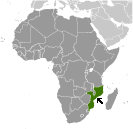World Atlas: Mozambique. On this page you can see the map, country flag and many detailed information about the people, history and economy of Mozambique.

Here you can find online selected information about the geography, inhabitants, government, economy and history of Mozambique. Included are selected statistics, an overview map and the detailed map of Mozambique. But let's start with the flag of Mozambique here:
Mozambique - Overview:
What you should know about Mozambique? Let's start with this: Almost five centuries as a Portuguese colony came to a close with independence in 1975. Large-scale emigration, economic dependence on South Africa, a severe drought, and a prolonged civil war hindered the country's development until the mid-1990s. The ruling Front for the Liberation of Mozambique (Frelimo) party formally abandoned Marxism in 1989, and a new constitution the following year provided for multiparty elections and a free market economy. A UN-negotiated peace agreement between Frelimo and rebel Mozambique National Resistance (Renamo) forces ended the fighting in 1992. In 2004, Mozambique underwent a delicate transition as Joaquim Chissano stepped down after 18 years in office. His elected successor, Armando Guebuza, served two terms and then passed executive power to Filipe Nyusi in 2014. Renamo’s residual armed forces have intermittently engaged in a low-level insurgency since 2012, although a late December 2016 ceasefire held throughout 2017.
Geography of Mozambique
 Where on the globe is Mozambique? The location of this country is Southeastern Africa, bordering the Mozambique Channel, between South Africa and Tanzania. Total area of Mozambique is 799,380 sq km, of which 786,380 sq km is land. So this is quite a large country. How could we describe the terrain of the country? This way: mostly coastal lowlands, uplands in center, high plateaus in northwest, mountains in west. The lowest point of Mozambique is Indian Ocean 0 m, the highest point Monte Binga 2,436 m. And the climate is tropical to subtropical.
Where on the globe is Mozambique? The location of this country is Southeastern Africa, bordering the Mozambique Channel, between South Africa and Tanzania. Total area of Mozambique is 799,380 sq km, of which 786,380 sq km is land. So this is quite a large country. How could we describe the terrain of the country? This way: mostly coastal lowlands, uplands in center, high plateaus in northwest, mountains in west. The lowest point of Mozambique is Indian Ocean 0 m, the highest point Monte Binga 2,436 m. And the climate is tropical to subtropical.
Inhabitants of Mozambique
Let's take a look how many people live in Mozambique. The number is: 26,573,706. So quite a lot people live here. Who lives here? African 99.66% (Makhuwa, Tsonga, Lomwe, Sena, and others), Europeans 0.06%, Euro-Africans 0.2%, Indians 0.08%. What are the languages in Mozambique? Emakhuwa 25.3%, Portuguese (official) 10.7%, Xichangana 10.3%, Cisena 7.5%, Elomwe 7%, Echuwabo 5.1%, other Mozambican languages 30.1%, other 0.3%, unspecified 3.7% (2007 est.). And the religions: Roman Catholic 28.4%, Muslim 17.9%, Zionist Christian 15.5%, Protestant 12.2% (includes Pentecostal 10.9% and Anglican 1.3%), other 6.7%, none 18.7%, unspecified 0.7% (2007 est.). How old are the people in average? 17.2 years. We have to add that this number is the median - so one half of the people is older than this, one half is younger. And what is their life expectancy (at birth)? This: 53.7 years. Where the people live in Mozambique? Here: three large populations clusters are found along the southern coast between Maputo and Inhambane, in the central area between Beira and Chimoio along the Zambezi River, and in and around the northern cities of Nampula, Cidade de Nacala, and Pemba; the northwest and southwest are the least populated areas. The major urban areas of Mozambique are: Maputo (capital) 1.187 million; Matola 937,000 (2015).
Government and Economy of Mozambique
The capital of Mozambique is Maputo and the government type presidential republic. Let's take a look at the administrative divisions - 10 provinces (provincias, singular - provincia), 1 city (cidade); Cabo Delgado, Gaza, Inhambane, Manica, Maputo, Cidade de Maputo, Nampula, Niassa, Sofala, Tete, Zambezia. Regarding the economy of Mozambique, important industrial products are aluminum, petroleum products, chemicals (fertilizer, soap, paints), textiles, cement, glass, asbestos, tobacco, food, beverages. Important agricultural products are cotton, cashew nuts, sugarcane, tea, cassava (manioc, tapioca), corn, coconuts, sisal, citrus and tropical fruits, potatoes, sunflowers; beef, poultry. The most important export commodities are aluminum, prawns, cashews, cotton, sugar, citrus, timber; bulk electricity and the most important export partners are Netherlands 30.8%, India 15.2%, South Africa 14.6% (2016). The most important import commodities are machinery and equipment, vehicles, fuel, chemicals, metal products, foodstuffs, textiles and the most important import partners are South Africa 36.6%, China 10.9%, Netherlands 7.8%, Bahrain 5.2%, France 4.2%, Portugal 4.2%, UAE 4.1% (2016). How rich is Mozambique and how rich are people in this country? The most important number here is GDP per capita (PPP): $1,300 (2017 est.). This is a very low number. Let's add that this means Gross Domestic Product per person, which is recalculated with respect to the relative cost of local goods and services. And one more important number - population below poverty line: 46.1% (2015 est.).